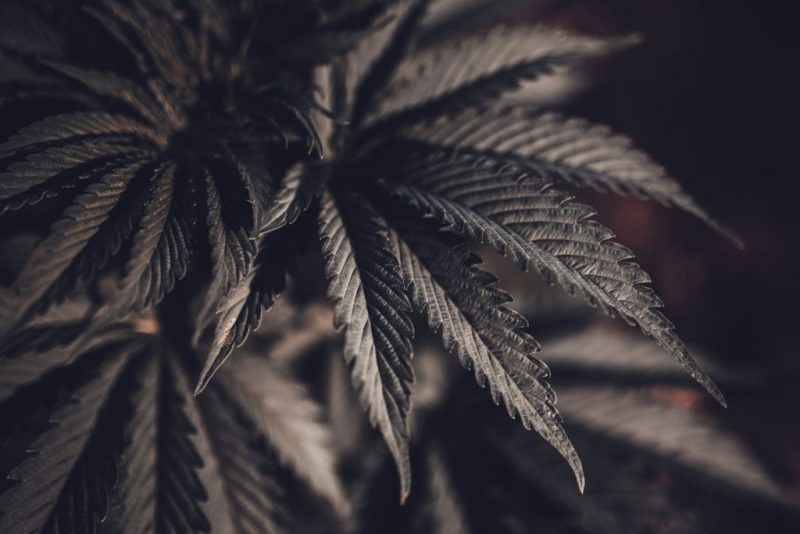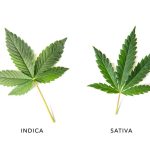🔥 Website for Sale - Contact Us
Cannabis fan leaves are not only iconic but also play a vital role in the overall health of the plant. These large, serrated leaves are the plant’s primary energy source, capturing sunlight for photosynthesis and supporting vigorous growth. However, fan leaves turning black can cause concern, as it indicates an underlying issue that could jeopardize the plant’s productivity.
In this comprehensive guide, we’ll explore the leading causes behind cannabis fan leaves turning black and provide practical solutions to prevent and address these issues. So, let’s dive in and uncover the secrets to keeping your fan leaves vibrant and green!
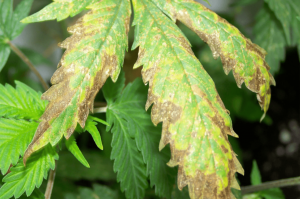
Why do cannabis fan leaves turn black?
Cannabis fan leaves can turn black due to various reasons, each of which can impact the plant’s overall health and well-being. Blackening of fan leaves is often a sign of stress on the plant, indicating that something is amiss in its growing environment, nutrient balance, or its exposure to pests and diseases. Here are the main reasons why cannabis fan leaves may turn black:
Nutrient Deficiencies: When cannabis plants lack essential nutrients, they become stressed, and this can manifest as blackening of the fan leaves.
Pests: Pests like spider mites, aphids, whiteflies, and thrips can cause direct damage to the fan leaves by feeding on the plant sap. Additionally, some pests excrete substances that attract mold, which can further damage the leaves.
Diseases: Various fungal, bacterial, and viral diseases can attack cannabis plants, causing symptoms such as blackening of fan leaves. Common diseases include Botrytis (bud rot), powdery mildew, Pseudomonas syringae, and mosaic virus.
Environmental Factors: The growing environment is crucial for the health of cannabis plants. Factors such as temperature, humidity, light intensity, and air circulation can contribute to blackening of fan leaves if not properly managed. I found that the best way to control the cannabis grow environment is by using proper equipment. Here is more about the best grow tent setup and essential accessories.
What are the signs of nutrient deficiencies causing blackening of fan leaves?
Nutrient deficiencies can cause a range of symptoms in cannabis plants, including blackening of fan leaves. Being able to identify these deficiencies and their impact on fan leaves is key to addressing the problem effectively. Here are some specific nutrient deficiencies that can lead to blackened fan leaves:
Nitrogen (N): Nitrogen is a critical nutrient for cannabis plants, playing a significant role in the formation of chlorophyll and overall growth. A nitrogen deficiency often manifests as yellowing and wilting of the lower leaves, which may eventually turn black and die if the deficiency persists.
Phosphorus (P): Phosphorus is vital for energy transfer within the plant and helps promote strong root development. A phosphorus deficiency can cause darkening of the leaves, initially appearing as purple or dark green, and eventually turning black. Leaves may also become twisted and exhibit a dry, brittle texture.
Potassium (K): Essential for regulating water and nutrient flow within the plant, potassium is crucial for overall plant health. A potassium deficiency can result in blackening leaf edges and tips, with a burnt appearance. Leaves may also curl, and the plant may exhibit stunted growth.
Calcium (Ca): Calcium is crucial for the formation and strength of cell walls. A calcium deficiency can lead to leaf deformation, with new growth appearing twisted or crinkled. The deficiency may cause blackened spots on leaves, and in severe cases, the affected leaves may die.
Magnesium (Mg): As a key component of chlorophyll, magnesium is essential for plant photosynthesis. A magnesium deficiency typically appears as yellowing between the leaf veins, with the veins themselves remaining green. As the deficiency progresses, the affected areas may turn brown or black.
To address nutrient deficiencies, assess the feeding schedule and ensure that they are providing the appropriate nutrients at the right concentrations. It’s also essential to monitor the pH level of the growing medium, as incorrect pH can hinder nutrient uptake.
How do pests contribute to blackening of cannabis fan leaves?
Some pests cause direct damage to the fan leaves, leading to blackening, while others indirectly contribute to the issue by stressing the plant and making it more susceptible to other problems. Here are some common pests that cause blackening of cannabis fan leaves and tips on how to deal with them:
Spider Mites: These tiny, spider-like creatures are notorious for damaging cannabis plants. They feed on plant sap, causing small, yellow speckles on the leaves. As the infestation progresses, the affected leaves may turn black and die. Spider mite infestations can be treated by introducing natural predators, such as ladybugs, or using insecticidal soap or neem oil sprays.
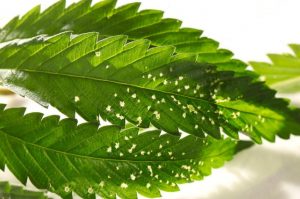
Aphids: Aphids are small soft-bodied insects that feed on plant sap, resulting in curled, distorted, and blackened leaves. They also excrete a sticky substance called honeydew, which attracts mold and can further damage the plant. To control aphids, try using insecticidal soaps, neem oil, or introduce beneficial insects like ladybugs and lacewings.
Whiteflies: These tiny, white insects are related to aphids and also feed on plant sap. They cause similar symptoms, including leaf curling, yellowing, and eventual blackening. Whiteflies can be managed using sticky traps, insecticidal soaps, or by releasing natural predators like ladybugs.
Thrips: Thrips are small, slender insects that pierce the plant’s cells and feed on the sap. They cause silvery streaks or spots on the leaves, which may eventually turn black and die. To control thrips, use insecticidal soaps, neem oil, or introduce beneficial predators like pirate bugs or lacewings.
Here are some preventative measures to keep pests at bay:
Maintain a clean growing environment: Regularly remove dead leaves and debris, and sanitize tools and equipment to minimize the risk of pest infestations.
Monitor your plants: Regularly inspect your plants for signs of pests, and act quickly to address any issues.
Implement proper ventilation and air circulation: Good airflow can help prevent pest infestations and reduce the risk of mold and other diseases.
Use physical barriers: Employ screens or netting to protect your plants from pests.
By staying vigilant and employing preventative measures, you can minimize the risk of pest-related blackening of cannabis fan leaves and ensure the overall health and vitality of your plants.
Which diseases can cause fan leaves to turn black?
Fungal Diseases: Fungi thrive in moist, humid environments and can cause various diseases in cannabis plants, leading to blackening of fan leaves.
Botrytis (Bud Rot): This fungus attacks the buds and can spread to fan leaves, turning them black and causing them to die off. To prevent and control Botrytis, maintain proper air circulation, reduce humidity, and remove any affected plant parts.
Powdery Mildew: Although this fungus typically appears as white, powdery spots on leaves, severe infections can lead to leaf discoloration, including blackening. Manage powdery mildew by optimizing air circulation, reducing humidity, and using fungicides or natural treatments like neem oil and baking soda.
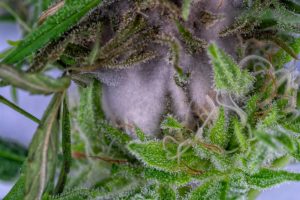
Bacterial Diseases: Bacterial infections can cause blackening of cannabis fan leaves and can spread quickly within a crop.
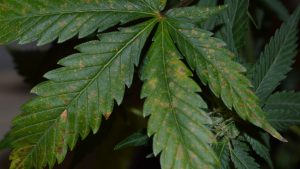
Pseudomonas syringae: This bacterium causes blackening and necrosis on leaves and stems. It thrives in cool, wet conditions, so preventing and managing it involves optimizing environmental conditions, removing affected plant parts, and using copper-based bactericides when necessary.
Viral Diseases: While less common, viral infections can cause a variety of symptoms in cannabis plants, including blackening of fan leaves.
Mosaic Virus: This virus affects many plant species, including cannabis. It causes mottled, yellow-green leaves that may eventually turn black and die. There is no cure for mosaic virus, so prevention is critical. Maintain strict hygiene in the grow area, control pests that may transmit the virus, and immediately remove and dispose of any infected plants.
Use disease-resistant strains: If possible, choose cannabis strains with a reputation for being resistant to diseases.
By proactively addressing diseases and maintaining a healthy growing environment, you can minimize the risk of fan leaves turning black.
How do environmental factors lead to blackening of cannabis fan leaves?
Poor Environmental conditions can stress the plant, making it more susceptible to pests, diseases, and nutrient deficiencies, which can ultimately lead to blackening of fan leaves. Here are some key environmental factors that can contribute to blackening of cannabis fan leaves:
Temperature: Cannabis plants have an optimal temperature range in which they thrive. Excessive heat can cause leaves to wilt, curl, and eventually turn black, while excessively cold temperatures can lead to darkened, drooping leaves. Maintain a consistent temperature within the plant’s optimal range to prevent temperature-related stress.
Humidity: Proper humidity levels are essential for preventing mold growth and maintaining healthy transpiration rates. High humidity can create a breeding ground for mold and pests, while low humidity can lead to leaf dehydration and blackening. Monitor and adjust humidity levels according to the plant’s growth stage to ensure a healthy environment.
Light Intensity: Light is crucial for photosynthesis, but excessive light intensity can cause light burn or heat stress, leading to blackening of fan leaves.
Air Circulation: Proper air circulation helps regulate temperature and humidity while reducing the risk of mold and pests. Poor air circulation can lead to stagnant air and increased humidity, causing mold growth and blackening of fan leaves.
Watering Practices: Overwatering or underwatering your cannabis plants can lead to root issues, nutrient deficiencies, and stress on the plant, potentially causing fan leaves to blacken. Maintain a consistent watering schedule and avoid letting the growing medium become too dry or waterlogged.
pH Levels: The pH level of your growing medium directly affects nutrient availability for your plants. Imbalanced pH levels can lead to nutrient deficiencies and lockout, causing fan leaves to blacken. Regularly test and adjust the pH of your growing medium to ensure optimal nutrient uptake.
What are the best practices for treating and recovering from blackened fan leaves?
Once you’ve identified the root cause of blackening fan leaves, it’s important to take action to treat the issue. Here are some best practices for treating and recovering from blackened fan leaves:
Address Nutrient Deficiencies: If nutrient deficiencies are the cause, adjust your feeding regimen to provide the necessary nutrients in the correct proportions. Monitor your plants closely and ensure that the growing medium has the appropriate pH level for optimal nutrient uptake.
Control Pests and Diseases: For pest-related issues, remove the affected leaves and treat the plants with a suitable insecticide or biological control agent. In case of diseases, prune away the infected leaves and apply a suitable fungicide or bactericide, depending on the pathogen.
Optimize Environmental Conditions: If environmental factors are contributing to the problem, adjust the temperature, humidity, light intensity, and air circulation in your growing space. Ensure proper watering practices and maintain a consistent schedule to avoid overwatering or underwatering your plants.
Prune Damaged Leaves: Carefully remove the blackened leaves to prevent the spread of pests or diseases and promote airflow around the remaining healthy foliage. Pruning also helps direct the plant’s energy toward new growth.
Provide Supportive Care: Encourage plant recovery by maintaining optimal growing conditions and providing the necessary nutrients. In some cases, it may be beneficial to use a foliar spray with trace elements, kelp extract, or other beneficial compounds to promote plant health.
Prevent Future Issues: Implement preventative measures, such as regular monitoring, proper sanitation, and maintaining a healthy growing environment.
By following these best practices, you can help your cannabis plants recover from blackened fan leaves and promote their health and productivity throughout the growth cycle.
Cannabis Training Techniques to Prevent Fan Leaves Turning Black
Low-Stress Training (LST)
Low-Stress Training (LST) is a gentle and effective technique that involves bending and securing branches to guide the plant’s growth, creating an even canopy and encouraging horizontal expansion. By implementing LST, you can ensure more efficient light absorption and better air circulation, reducing the risk of issues that can lead to blackened fan leaves.
To implement LST effectively, start training when the plant is young and more pliable, gently bend branches away from the main stem, and secure them using soft plant ties, garden tape, or string. Adjust the ties as the plant grows, maintaining an even canopy and ensuring equal light exposure for all branches. Combine LST with other training techniques, such as topping or pruning, for optimal results.
High-Stress Training (HST)
High-Stress Training (HST) involves techniques that cause more significant stress to the plant, such as supercropping, topping, and fimming. These methods can help prevent blackening of fan leaves by promoting a more even canopy and improved air circulation. When implementing HST techniques, be careful not to cause undue stress on the plant, as this can lead to other issues.
Screen of Green (SCROG)
The Screen of Green (SCROG) method involves placing a horizontal screen or net above the growing cannabis plants, guiding their growth through the screen to create an even canopy. This technique improves light distribution and air circulation, preventing blackening of fan leaves by reducing the risk of mold and pests. Set up and maintain a SCROG system by weaving the branches through the screen as they grow, maintaining an even canopy height.
Sea of Green (SOG)
The Sea of green (SOG) technique involves growing multiple smaller plants close together, encouraging them to focus on vertical growth. This method helps prevent blackening of fan leaves by optimizing light penetration and air circulation.
Pruning and Defoliation
Regular pruning and defoliation can help increase yield and prevent blackening of fan leaves by promoting air circulation, light penetration, and overall plant health. Remove dead, damaged, or unnecessary leaves and branches, and ensure that all parts of the plant receive adequate light and airflow.
Conclusion: Cannabis training techniques can play a significant role in preventing fan leaves from turning black. By implementing methods such as Low-Stress Training, High-Stress Training, Screen of Green, Sea of Green, and regular pruning and defoliation, you can optimize plant growth, improve light penetration, and promote better air circulation. These practices not only prevent blackening of fan leaves but also help maintain healthy cannabis plants and maximize yields.
Overwatering
Giving your ladies too much water can cause all sorts of serious negative consequences including turning leaves black. Typically once fan leaves turn black because of too much internal moisture rot has already taken control and the damage is irreversible. Luckily the rot does not affect the entire plant overnight and allows the opportunity to take quick action to readjust the care-taking course.
Quality pot soil prevents overwatering
To prevent fan leaves turning black, use quality pot soil that has good drainage properties. Unlike humans, plants will drink water till nothing is left instead of drinking until hydrated. Using random outside soil with poor drainage properties will result in more available water for the plant to absorb.
Before leaves turn black from overwatering, the plant will experience other symptoms that can help the grower identify the problem before plant rot has set in. While overwatering symptoms can closely resemble nutrient deficiency, there are two notable signs to help diagnose the problem.
Signs of Overwatering
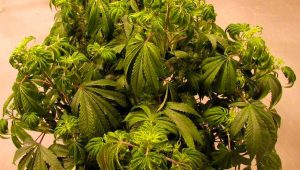
Once plants absorb too much water the leaves start to droop and swell from excess liquid. The swelling happens because the plant absorbs water quicker than its ability to transpire moisture back into the atmosphere.
Although overwatering is not the only reason preventing the plant to breathe, it does set in motion a chain reaction that accelerates the process.
Another sign to look out for happens directly after watering your plants. If fan leaves start swelling immediately after watering this is a sure indicator that plant rot will set in and turn the leaves black if watering maintenance is not adjusted.
Treating Overwatering Symptoms
Once overwatering is diagnosed as the culprit, the treatment is pretty straightforward. Stop watering your plants until the leaves start to wither and curl for dehydration. You can verify that these symptoms are actually from dehydration instead of overwatering by sticking a finger about knuckle deep into the soil. If the soil is moist, you need to wait longer until dried out. Once you verified that the pants are experiencing mild dehydration it is time to give your ladies a drink of water.
Be careful not to give too much water at a given time. The easiest way the estimate the right amount of water the plants need is by following this simple procedure. The first step, verify that you are using quality pot soil and use its saturation ability to calculate watering needs. Proper pot soil drains about 25% of the water to the overflow tray which indicates that the soil is 100% saturated with water.
In the second step, measure the amount of water used per plant and increase the measure until 25% is collected in the overflow tray. Once the soil is 100% saturated, remember to remove the liquid from the overflow tray to prevent the plant from absorbing it.
While overhydration can be easily treated, plant rot from high humidity is permanent and can result in total plant death. Removing open pools of water from a grow tent is critical to help reduce humidity without the use of a dehumidifier.
Fertilizer

The most common response for fan leaves turning black is to use fertilizer to combat the symptoms because they can closely resemble a nutrient deficiency. However, making a wrong diagnosis can be fatal to your plants. Usually, bad outcomes like plant death are many harmless problems working together to create a perfect storm.
High temperature and humidity accelerate the plant’s metabolism and result in the cannabis absorbing more water than it can handle.
While overhydration is mostly harmless, aborting too much nutrient-rich water from fertilizer can cause serious problems like nutrient burn and blackening fan leaves.
Bacteria Infections

Bacteria infection is extremely dangerous to all plants and can wipe out your entire crop. If a bacterial disease breaks out in your grow room it can quickly spread throughout the entire crop if unnoticed.
Following best practices can drastically lower the risk of bacterial infection. However, sometimes it’s more tricky to prevent because the infection can come from the farm you buy clones.
Although clones can be a high risk for bacteria, the biggest contributor to bacterial infection is cross-contamination between plants from pruning. Much like humans, open wounds on a plant are the ideal entry point for harmful diseases. When pruning your ladies always use sharp and sterile shears or sculpting blades to prevent cross-contamination of bacteria.
Using sterile equipment when doing plant surgery is an effective precaution but should also be accompanied by good housekeeping practices. Keep your grow space clean by removing any open water pools like spillages or overflow water from the pot tray. Stagnating open water sources in a grow room is the perfect environment for pests and diseases.

